Dance as Social Action
An Interview with Ana Maria Alvarez, director of CONTRA-TIEMPO
BY EMMALY WIEDERHOLT
Ana Maria Alvarez is a dancer, choreographer, and teacher based in Los Angeles and the director of CONTRA-TIEMPO, a multilingual activist dance theater company. Here, Ana Maria reflects on some of CONTRA-TIEMPO’s history and influences, how the company draws on dances from the Afro-Latine diaspora, and why she believes in dance as a tool for building a more loving and just future.
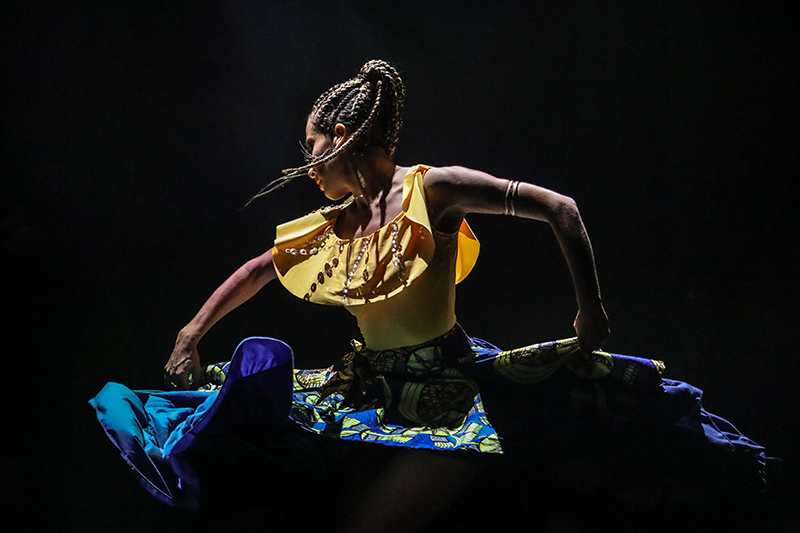
CONTRA-TIEMPO performs joyUS justUS at USC, Photo by Steve Wylie
~~
Can you share with me a little about your dance history? What shaped you as an artist?
My parents were in the Labor Movement, so I grew up in and on the picket lines and in an engaged household. We moved a lot, but the consistent thing I practiced was dance. I studied ballet, tap, and jazz since I was about five. I started specializing in ballet in high school, and then got disillusioned with ballet because my teacher told me my butt was too big. I found Afro-Cuban, Afro-Haitian, and West African dance. I also was exposed to Dunham technique while in college. I found my way into the diaspora. I should preface that I’m Cuban American, so I grew up dancing salsa with family and at parties, but never studied it until I was in my teens. I worked with Urban Bush Women from when I was 18 to 21, interning with them and going to their first Summer Leadership Institute. I also was a child of the 90s and grew up with 90s hip-hop. And then I studied tango in Argentina when I was in college. My artist identity is hybridized. In my early 20s, I found my own creative voice, which brought together all these parts of me. I started doing choreography in my 20s in New York while I was working for a social service agency. I moved to UCLA to get my masters in Choreography and never left Los Angeles. I’ve lived in LA longer than anywhere, so in a funny way this feels more like home because it’s the most consistent place I’ve lived.
How did you find CONTRA-TIEMPO? What was the impetus?
CONTRA-TIEMPO was my thesis concert. It was an exploration of salsa as a metaphor for resistance. There’s this idea that pushing back as resistance is seen as negative. I was clear in my practice, study, and teaching of salsa that you needed that resistance to communicate. It was fundamental to clear communication and building relationship. If you don’t have resistance, it’s like dancing with a floppy noodle. I thought it was an incredible metaphor for the politics at the time. It was the Bush era, and there was this “for us or against us” talk, naming people “anti” because of their desire to resist and push back. I made a work called CONTRA-TIEMPO. Contra tiempo is the offbeat that makes music so delicious and yummy.
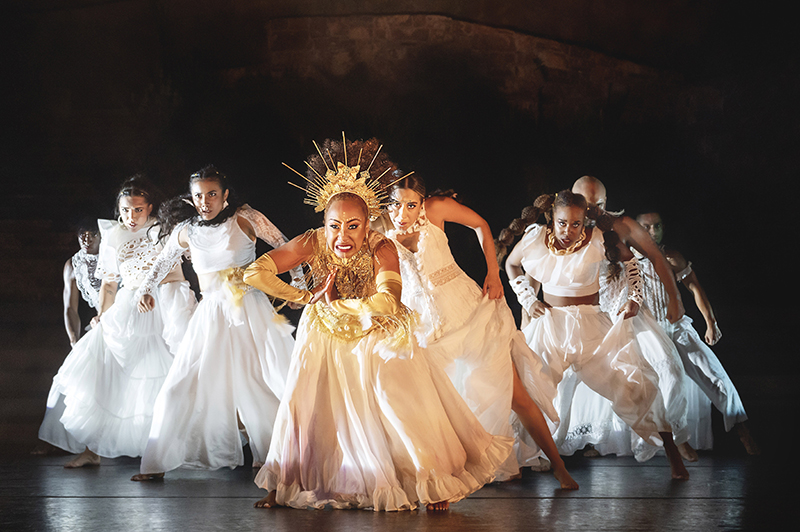
CONTRA-TIEMPO performs ¡azúcar!, Photo by Tyrone Domingo
How would you describe the company’s work to someone unfamiliar with it?
Our work is rooted in art as social action and dance as a tool for building a more loving and just future. Our vocabulary and the languages we speak are of the Afro-Latine diaspora. We play deeply in Afro-Cuban tradition, particularly salsa. We also play in grooves, improvisation inside rhythm making, Black vernacular dance in the US, like jazz and hip-hop. Also Dunham’s work has shown up a lot. Her legacy and movement were something I felt deeply connected to in terms of her bringing the African diaspora into the language of contemporary dance in the US, as well as her role as an anthropologist deeply understanding the politics, nation, and people of a dance instead of extracting movement. All of those became part of the vocabulary inside our work.
I have choreographed and directed all our work except for one piece by Marjani Forte. As a choreographer, I work collaboratively. I’m interested in dancers not looking like cookie cutters. I want artists with clear strong identities and ways of playing, moving, and engaging inside these ancestral technologies that are the container of CONTRA-TIEMPO. A lot of the work we create feels like fusion, though I hate that term because it sounds like everything has morphed into one thing. We look more like the way pico de gallo looks, where you can recognize the wholeness of the individual ingredients.
Are there one or two pieces in the company’s repertoire that you’d like to share more about? For instance, one of the pieces that seems pivotal to the company is joyUS justUS.
joyUS justUS feels like CONTRA-TIEMPO’s Revelations. It’s the piece we’re probably going to be performing forever. It is an incredibly relevant piece that crosses over multiple struggles, issues, and concerns. It is about radical joy and joy as a mechanism for social change and a way of recognizing power in a world that often doesn’t have us engaged and in touch with that power even though it is a birthright. It’s about the justice system, but really about radical joy, no matter the issue.
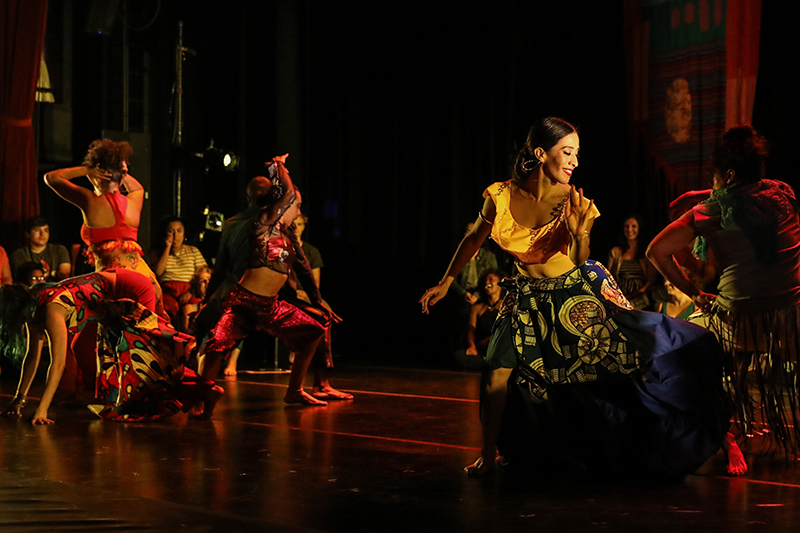
CONTRA-TIEMPO performs joyUS justUS at USC, Photo by Steve Wylie
¡azucar! is a current piece that is the word for sugar in Spanish. It felt like our harkening back to our roots of salsa and Afro-Cuban dance. I was interested in the ways in which our understanding of history, colonization, and how we got here shapes our present and future. In the Americas, there’s this deep denial of anti-Blackness. It’s a result of white supremacy and assimilation to get closer proximity to whiteness. The idea for the piece was to take sugar and look at its history as a way of looking at collective suppression and liberation and our capacity for transformation and healing. The piece has become about healing even though it didn’t start that way. I thought it was going to be about history and grappling with anti-Blackness, but it became about healing. It’s a radical protest and claiming of space inside of deep ancestral healing.
We just finished a Pillow Lab and did an excerpt of the piece in a church. It was a profound experience to do this expression of deep ancestral healing inside a building that is representative of Christian organized religion and the ways Christian organized religion participated in colonization and the enslavement of Africans. We realized we need to do ¡azucar! in more churches. I’m performing an excerpt with some of our students at USCD in April. The students will be the community cast and perform with the company.
The work we make and generate has invited in a community cast as part of the core work for the past four pieces. Whether it’s local or touring, having a community cast engages local dancers to be part of the process through three rehearsals to have a short, intense, and deep experience with the work. Locally it’s beautiful to connect with the people who live in the places where we are visiting, and on tour we get to create bridges to link us meaningfully to the people we are working with and their families, friends, co-workers, neighbors. It’s been a model that I think is a beautiful expression of how CONTRA-TIEMPO enters and exits community.
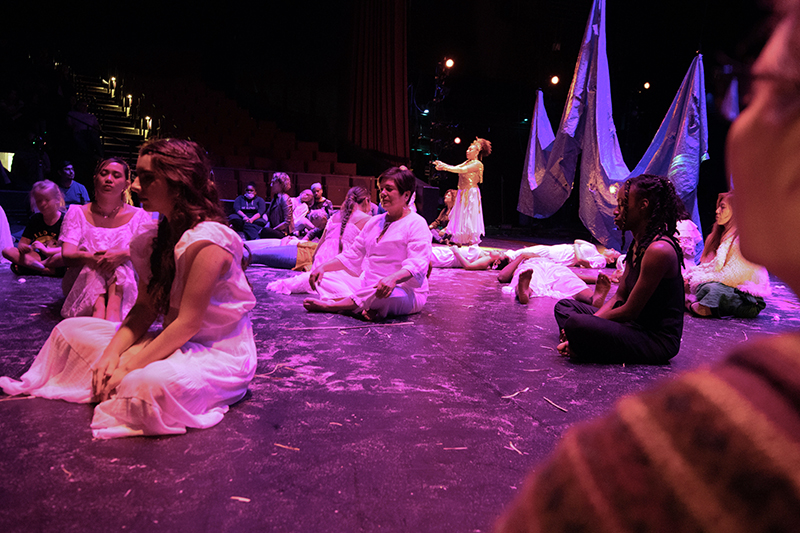
CONTRA-TIEMPO performs ¡azúcar! with the community, Photo by Robert Davezac
There’s one more piece I want to share. holly johnston has been working with us as a somatic ecologist. She is going to be collaborating with us on a work called Roots of Loving Us. She has been working with our bodies and doing individual sessions throughout ¡azucar!, engaging and connecting with healing in real time inside the artistic process. If someone has pain, she’s right there and immediately addressing what the body needs. It’s creating this environment centering care. Dancers can come out of an artistic process more whole and healed. Roots of Loving Us is moving deeper into the work of healing through the perspective of family. holly is adopted and I adopted both of my children. There’s something powerful about what it means to manifest family and generate that deep lineage connection that is chosen. “Familying” is a verb, not a noun. We’re going to be working with folks who work in foster care, transracial adoptions, birth families, families who come in contact with each other through inheritance, basically different iterations of what family means. It’s this exploration of what it means “to family” as an action and a liberation practice. I would describe holly’s roll in this new work Roots of Loving Us as she is choreographing and we are co-leading this new artistic process. We’re in the beginning process of this work.
Why is it important to make politically relevant work? How can dance contribute to conversations of social justice and change?
So often, we think about dance as abstraction, and specifically concert dance. The work we do has play within nonlinear storytelling and abstraction. However, because of the grounding, ancestral technologies, and resilience-building practices that have existed for generations beyond us, there is a deep wisdom and lineage we are holding beyond our own relationships and we are being informed by those who came before us. The body itself is the most powerful communicator and entry point for understanding joy, resilience, relationship, connection, and shared liberation. You don’t understand those concepts until you understand them in your body. So often, other artistic mediums have held the responsibility, whether through visual art, song, or spoken word, for holding meaning. Whereas if we grapple with what it means to be a human being and build a world that is more loving and just, it has to start with our bodies. It’s the entry point to ourselves and each other, and the access point to feeling. The emotional connection of what it is you’re theorizing, engaging in, none of it matters until you feel it in your body.
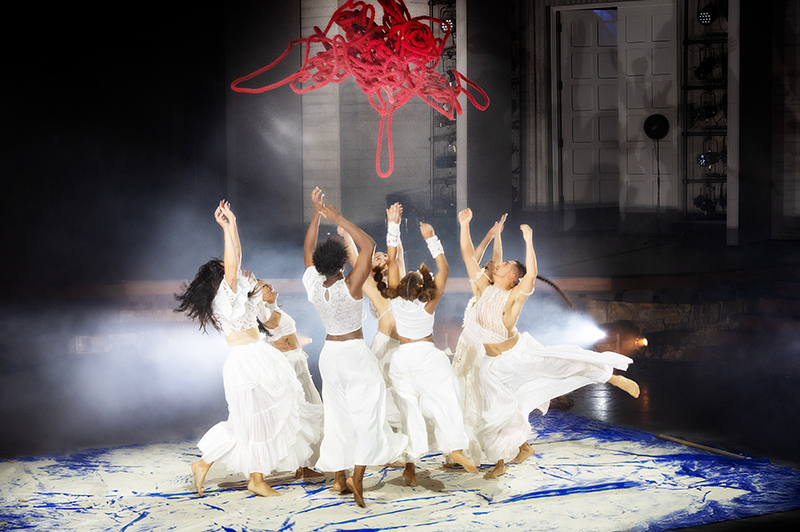
CONTRA-TIEMPO performs ¡azúcar!, Photo by Tyrone Domingo
With that said, I’m in the theater and dance department at USCD, and I find myself constantly having to explain that dance has the capacity to tell stories and take on systems that are deeply entrenched in inequality and trauma. Our bodies have a real capacity to have us engage differently, but it’s an ongoing conversation.
What’s been interesting about ¡azucar! is it has the least amount of words and text than my previous pieces. I wanted to challenge myself to make a work that asks the body to show up. There are a couple of hints of words here and there embedded in the score, but it’s not about the words at all; it’s about the body.
Any other thoughts?
I just got this position at UCSD. I am a tenured faculty member and inherited being head of dance. We’re doing some incredible and radical transformation inside the academy centering lots of embodied practices beyond ballet and modern. It’s a deep alignment with and the next phase of CONTRA-TIEMPO’s work. We’ve been in many ways building a movement outside of major institutions and systems, but now I’m in a major institution. The muscles I’ve been building in CONTRA-TIEMPO are being applied in real time.
~~
For more info, visit www.contra-tiempo.org.

2 Responses to “Dance as Social Action”
Thanks Cynthia! What important work your friend Dr. Mark Seton in Australia and holly johnston are doing!
Once again grateful that you are lifting up this important dancer and the deeply connected wisdom. One of my friends in Australia, Dr. Mark Seton, works at the intersection of theater and the health of actors- noting that embodied imagination can also harm those who enact painful stories. In the article, I celebrate the guidance to bring in holly Johnston, a somatic ecologist, doing individual sessions that connect to healing in real-time inside the artistic process. “If someone has pain, she’s right there and immediately addressing what the body needs. It’s creating this environment centering care. Dancers can come out of an artistic process more whole and healed.” This beautifully models a generative and not retraumatizing understanding.